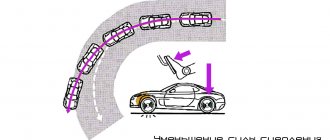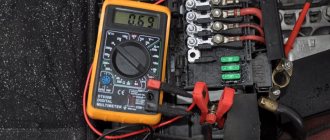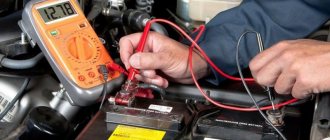While the car's power plant is inactive, the on-board network is powered from an external power source - the car battery. Also, the power plant itself is started using the battery's electricity.
Any motorist should know how and how to charge the battery of his car.
The need to properly charge a car battery
But the battery does not generate energy to power the network, it only stores it within itself, releases it when necessary, and then restores its charge from the car’s generator.
The charge-discharge cycle does not benefit the battery itself; over time, its charge decreases, that is, the battery is slowly discharged, it is not possible to completely restore the amount of energy from the generator, and eventually the battery charge will no longer be enough to start the engine. In this case, the question arises: how to charge the car battery. This operation is performed using chargers. But before describing the process of charging a battery, let’s figure out what types of batteries there are in cars, their main parameters that are taken into account when charging, types of chargers, the principle of their operation, rules for charging a car battery and what should not be done when performing the operation.
Video: Battery explosion
All batteries are structurally similar. There is a set of plates that play the role of electrodes, some are positive, others are negative. In order for a chemical reaction to occur between the plates, which results in the release of electricity, the space between the plates is filled with electrolyte. Depending on the type of battery, the electrolyte is either a solution of acid with water or a solution of alkali with water.
Parallel connection of the second battery to the car
When it is necessary to remove the battery from a car, electricians often use the following method to prevent the car’s electronic system from resetting its parameters:
- A 12 Volt battery is taken, which is sufficiently charged to support the car’s electronic system in offline mode;
- Using special wires, the battery is connected in parallel to the terminals of the car;
- Next, the main battery is turned off, but the machine’s electronic system continues to be powered by an additional energy source.
By replacing the battery in your car, you can easily charge the main battery and then return it back. The complexity of this method is that the car owner does not always have a spare battery and wires for parallel connection of an additional power source.
Article on the topic: In what cases is it necessary to remove the seats?
Types of batteries
The following types of batteries are used in cars: acid, alkaline and gel. There is another type of battery - lithium-ion, but due to their characteristics, these batteries cannot start the engine, so in cars they are currently only used as an additional battery.
This is how a car battery works
Acid batteries have electrodes made of lead, which contains additional impurities. Lead as an electrode material is used because this material has good energy capacity and can produce high currents in a short period of time. The electrolyte in these batteries is an acid solution. These are the most common batteries used in cars.
Alkaline batteries do not have lead plates, but nickel-cadmium or nickel-iron plates. And the space between them is filled with a solution of caustic potassium. These batteries are not often used in passenger cars, since their current strength is lower than that of acid batteries.
Gel batteries appeared relatively recently. In fact, this is the same acid battery, only its electrolyte is in a jelly-like state. These batteries are promising, but a number of technological features of these batteries do not allow them to be widely used, and they are not very expensive.
In addition, batteries are also divided into serviceable and maintenance-free. Acid batteries are serviceable only. And all because during a chemical reaction, part of the water from the solution evaporates. In order for the electrolyte to have the appropriate density, it is necessary to periodically check the condition of the electrolyte and add water if necessary.
Only distilled water is used to top up the battery.
Gel batteries are maintenance-free. They have a sealed housing. During a chemical reaction, their water does not evaporate. Therefore, it does not require topping up.
Is it possible to charge a battery without removing the terminals and battery?
Despite its fairly simple device, a car battery still remains one of the most complex and incomprehensible parts of a car. Motorists have a lot of traditional questions related to its proper operation, and one of them is the question of whether it needs to be charged, how often to do it, and whether it is always necessary to remove it for this. Any battery needs periodic charging and, basically, this requires its removal - for example, during mandatory maintenance.
It will also require charging if it just sits down and is unable to provide adequate starting current. This often happens when some electrical device is running in the car all night - radio, headlights or dimensions, interior lighting. In other cases, the battery does not need to be charged. Subject to regular monitoring of battery voltage, which is recommended 4-5 times a year. To do this, it is enough to use an ordinary ammeter. In cold weather, the frequency of monitoring can be increased.
Types of chargers for charging the battery
In the future, we will consider proper battery charging using the example of common acid batteries. But for now let's go over the chargers.
Battery charger
Any charger is an electricity converter. The simplest charger circuit is a step-down transformer and a diode bridge. The principle of operation is as follows: an alternating voltage of 220 V, passing through a transformer and a diode bridge, is converted into a direct voltage of 14-15 V, which is required to charge the battery.
Often, the design of the charger includes additional control sensors - ammeters and voltmeters, voltage and current regulators, fuses. Although there are chargers in which the current and voltage for each battery are selected automatically.
Something else useful for you:
- Battery life, what determines battery life, how to extend it?
- What are the consequences if you mix up the terminals on a car battery?
- Battery polarity: Direct and Reverse how to determine?
How to properly charge the battery without removing it from the car
In practice, many novice drivers do not know how to solve a problem that suddenly arises. In fact, everything is not so difficult, the main thing is to follow certain instructions, not forgetting about general precautions.
Volkswagen
As a clear example, we can cite the algorithm of actions for such a popular car brand as Volkswagen. It consists of performing the following steps:
- First of all, you need to connect the charger wires in pairs to the battery terminals (plus to plus, minus to minus).
- If necessary, you can not even remove the battery plug, in which case the substances released during charging will exit through the ventilation holes in the plug itself.
- If there is no increase in the acid density indicator within two hours, the battery is fully charged.
In addition to safety precautions, a mandatory condition for compliance is the level of charging current, which at the initial stage should not exceed 10% of the total battery capacity.
Further, this indicator should automatically decline.
Renault
It is recommended to perform almost identical actions when charging without removing the battery on Renault models, although experienced motorists still advise limiting yourself to only one positive terminal, removing the negative one. In addition, you should ensure that the charging terminals do not come into contact with the car body.
Peugeot 308
This French small car can easily be charged without removing the battery, which is even more useful for the car itself, given the evaporation of the electrolyte during charging in the removed state. It is important to follow the connection sequence in order to avoid failure of the fuses on the charger being used.
The voltage in this case should be 14-16 V while maintaining a constant current and its initial value of 25-30 A. As the battery is charged, this figure will gradually decrease, and if you have to work with boosters, then all these values are quite easy to control.
Ford Kuga
The American crossover battery is also charged in two ways: with and without removal. In this case, the maximum voltage level does not exceed 15.5 V, since anything higher is already dangerous for the car. In addition, there are a number of other conditions that must be met. Among them:
- Connect to the network only after connecting the charger to the battery. Disconnection is carried out in the same sequence - first charging from the network, and then from the battery.
- It is unacceptable to start the engine and other power units during charging.
- First of all, the “plus” is connected, and then the “minus”. Disabling is done the other way around - first “minus” and then “plus”.
Also, do not forget about special devices that allow you to obtain the most accurate information about the serviceability and condition of the battery, because it is possible that the unit has simply outlived its useful life and needs to be replaced.
Features of car battery charging
Before you charge your car battery, there are several battery charging parameters to consider.
- The most optimal current for charging the battery is 10% of the rated energy capacity of the battery. That is, with a battery energy capacity of 60 Ah, the current should not exceed 6 A.
- The optimal voltage at the charger terminals is +10% of the rated voltage of a fully charged battery. For example, a fully charged battery has a terminal voltage of 12.6 V. 10% of the rated voltage is 1.26 V, add it to 12.6 V and get the optimal voltage of 13.86 V.
- It is possible to quickly charge the battery. Such charging is performed with high currents - 20-30 A. But such charging damages the battery, so it is better to refrain from such charging.
- When charging a gel battery, it is important not to exceed the critical voltage for such a battery, which is usually 14.2 V.
These are the main criteria taken into account in order to properly charge a car battery. Let's move on directly to how to charge a car battery.
Tips for car battery care
In conclusion, let's look at preventative measures that will help avoid problems when operating a car. Most of these measures do not take much time and can significantly extend the life of the battery. The main preventive measures are presented below:
- Periodically recharge the battery using a network charger. Ideally, you need to carry out a control-training cycle. CTC is not recommended for calcium batteries sensitive to deep discharge. In winter, the charging frequency should be higher. If possible, in winter you should avoid short trips and frequent engine starts;
- Keep electrical wiring, the car's alternator and the car's voltage regulator in good condition. Periodically check the voltage at the battery terminals while the engine is running. Normal voltage is 13-14.4 volts with headlights, music and heated windows on;
- Check the electrolyte level regularly. This can be done with a glass tube. The level should be 10-15 millimeters above the plates. If necessary, add distilled water. This does not apply to maintenance-free car batteries;
- Keep the battery case and terminals clean. It is necessary to eliminate traces of oxidation and corrosion, wipe off dirt and electrolyte leaks. This will reduce the self-discharge of the battery. The terminals can be coated with a special anti-oxidation compound;
- Periodically measure the density of the electrolyte. The normal value on a charged battery is 1.27 g/cm3. Adjust density if necessary. How to do this is described in the article entitled “What acid is in a car battery and what is the electrolyte for”;
- If you leave the car parked for a long period, then remove the battery from it, charge it and store it separately.
Now you know how to charge the battery without removing it from the car.
In principle, nothing complicated if everything is done carefully. If you have anything to add on the topic, or have any questions, write to us in the comments below. Also rate the material and vote in the poll below. Published in Batteries
Preparatory work
First you need to make sure that the battery is really discharged. To do this, you need to remove it from a niche in the car. In addition to the natural discharge of the battery due to its operation, the cause of the discharge may be damage to the battery case, as a result of which the electrolyte leaks out and the chemical reaction does not take place in it. Therefore, after removing it, you need to clean it from dust and dirt and carefully inspect the battery case. If there is a crack and electrolyte has leaked through it, such a battery cannot be used further.
You can determine whether the battery is discharged using a color indicator, which is often installed on the case cover. The colors in the indicator may be different, so you should pay attention to the explanation sticker, which is usually pasted next to the indicator.
You can also check the state of charge of the battery by the voltage at the terminals. To do this, you can use a regular tester. When the battery is discharged, the voltage will be lower than rated.
Before charging your car battery, you should also check the electrolyte. Through the filler plugs you can monitor the condition and amount of electrolyte; in normal condition, the electrolyte should be clean, transparent and free of impurities, and its level should be above the plates. If the level is lower, you need to add distillate.
You should also check the ventilation hole in the battery cover. It should not be clogged, otherwise there will be no escape for the fumes.
Is it dangerous to charge a battery without disconnecting the terminals from the car?
The engine, starter, generator and battery always have an increased load, which often leads to rapid battery discharge and the inability to start the car. Often in such a case, car owners think about whether it is possible to charge the battery without removing it from the car and without removing the terminals. Let's talk in more detail about whether it is possible to charge the battery in this way or whether this can lead to serious malfunctions.
Basic battery parameters
The duration of flawless operation of the power source is also influenced by the correct choice of battery when purchasing. Here are a few parameters that a motorist needs to pay attention to in a store or at a car market.
- One of the important indicators is the battery dimensions. Under no circumstances should you purchase larger batteries. They cannot be securely fastened to the body.
- The battery electrodes must exactly match the location of the electrical wire terminals.
- The release date of the battery also directly affects the operating life of the device. Leaving the battery in a warehouse or store for a long time without recharging negatively affects the durability of the power source.
- The capacity of the purchased model must exactly match the vehicle's passport data.
- It is better to purchase a battery at specialized retail outlets, where the seller can check the serviceability of the car's wiring and issue a warranty card.
The battery does not require large financial outlays for maintenance from the car owner. It is enough to periodically inspect the condition of the terminals, clean off any deposits that have appeared, and check the reliability of the fastening in order to maintain the functionality of the battery for a long time. And regular recharging of the current source (once every 3-6 months) with a stationary charger will allow you to start the engine in any weather.











